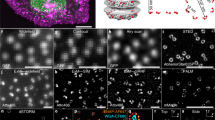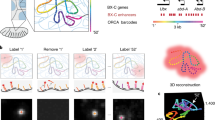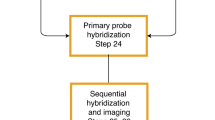Abstract
3D structured illumination microscopy (3D-SIM) is the super-resolution technique of choice for multicolor volumetric imaging. Here we provide a validated sample preparation protocol for labeling nuclei of cultured mammalian cells, image acquisition and registration practices, and downstream image analysis of nuclear structures and epigenetic marks. Using immunostaining and replication labeling combined with image segmentation, centroid mapping and nearest-neighbor analyses in open-source environments, 3D maps of nuclear structures are analyzed in individual cells and normalized to fluorescence standards on the nanometer scale. This protocol fills an unmet need for the application of 3D-SIM to the technically challenging nuclear environment, and subsequent quantitative analysis of 3D nuclear structures and epigenetic modifications. In addition, it establishes practical guidelines and open-source solutions using ImageJ/Fiji and the TANGO plugin for high-quality and routinely comparable data generation in immunostaining experiments that apply across model systems. From sample preparation through image analysis, the protocol can be executed within one week.
This is a preview of subscription content, access via your institution
Access options
Access Nature and 54 other Nature Portfolio journals
Get Nature+, our best-value online-access subscription
$29.99 / 30 days
cancel any time
Subscribe to this journal
Receive 12 print issues and online access
$259.00 per year
only $21.58 per issue
Buy this article
- Purchase on Springer Link
- Instant access to full article PDF
Prices may be subject to local taxes which are calculated during checkout





Similar content being viewed by others
References
Hell, S.W. Far-field optical nanoscopy. Science 316, 1153–1158 (2007).
Schermelleh, L., Heintzmann, R. & Leonhardt, H. A guide to super-resolution fluorescence microscopy. J. Cell Biol. 190, 165–175 (2010).
Demmerle, J., Wegel, E., Schermelleh, L. & Dobbie, I.M. Assessing resolution in super-resolution imaging. Methods 88, 3–10 (2015).
Huang, B., Babcock, H. & Zhuang, X. Breaking the diffraction barrier: super-resolution imaging of cells. Cell 143, 1047–1058 (2010).
Liu, Z., Lavis, L.D. & Betzig, E. Imaging live-cell dynamics and structure at the single-molecule level. Mol. Cell 58, 644–659 (2015).
Gustafsson, M.G. Surpassing the lateral resolution limit by a factor of two using structured illumination microscopy. J. Microsc. 198, 82–87 (2000).
Heintzmann, R. & Cremer, C. Laterally modulated excitation microscopy: improvement of resolution by using a diffraction grating. Proc. SPIE 3568, 185–196 (1999).
Gustafsson, M.G. et al. Three-dimensional resolution doubling in wide-field fluorescence microscopy by structured illumination. Biophys. J. 94, 4957–4970 http://dx.doi.org/10.1529/biophysj.107.120345 (2008).
Schermelleh, L. et al. Subdiffraction multicolor imaging of the nuclear periphery with 3D structured illumination microscopy. Science 320, 1332–1336 (2008).
Fornasiero, E.F. & Opazo, F. Super-resolution imaging for cell biologists: concepts, applications, current challenges and developments. Bioessays 37, 436–451 (2015).
Lakadamyali, M. & Cosma, M.P. Advanced microscopy methods for visualizing chromatin structure. FEBS Lett. 589, 3023–3030 (2015).
Gao, J.Y.X.N.M., Yang, D., Xi, W.P. & Zhang, M.Q. Developing bioimaging and quantitative methods to study 3D genome. Quant. Biol. 4, 129–147 (2016).
Wegel, E. et al. Imaging cellular structures in super-resolution with SIM, STED and localisation microscopy: a practical comparison. Sci. Rep. 6, 27290 (2016).
Ricci, M.A., Manzo, C., Garcia-Parajo, M.F., Lakadamyali, M. & Cosma, M.P. Chromatin fibers are formed by heterogeneous groups of nucleosomes in vivo. Cell 160, 1145–1158 (2015).
Boettiger, A.N. et al. Super-resolution imaging reveals distinct chromatin folding for different epigenetic states. Nature 529, 418–422 (2016).
Fraser, J., Williamson, I., Bickmore, W.A. & Dostie, J. An overview of genome organization and how we got there: from FISH to Hi-C. Microbiol. Mol. Biol. Rev. 79, 347–372 (2015).
Nora, E.P. et al. Spatial partitioning of the regulatory landscape of the X-inactivation centre. Nature 485, 381–385 (2012).
Dekker, J. Mapping the 3D genome: aiming for consilience. Nat. Rev. Mol. Cell Biol. 17, 741–742 (2016).
Fabre, P.J. et al. Nanoscale spatial organization of the HoxD gene cluster in distinct transcriptional states. Proc. Natl. Acad. Sci. USA 112, 13964–13969 (2015).
Shivanandan, A., Radenovic, A. & Sbalzarini, I.F. MosaicIA: an ImageJ/Fiji plugin for spatial pattern and interaction analysis. BMC Bioinformatics 14, 349 (2013).
Collins, T.J. ImageJ for microscopy. Biotechniques 43, 25–30 (2007).
Schneider, C.A., Rasband, W.S. & Eliceiri, K.W. NIH Image to ImageJ: 25 years of image analysis. Nat. Methods 9, 671–675 (2012).
Carpenter, A.E. et al. CellProfiler: image analysis software for identifying and quantifying cell phenotypes. Genome Biol. 7, R100 (2006).
Soliman, K. CellProfiler: novel automated image segmentation procedure for super-resolution microscopy. Biol. Proced. Online 17, 11 (2015).
Ollion, J., Cochennec, J., Loll, F., Escude, C. & Boudier, T. TANGO: a generic tool for high-throughput 3D image analysis for studying nuclear organization. Bioinformatics 29, 1840–1841 (2013).
Cerase, A. et al. Spatial separation of Xist RNA and polycomb proteins revealed by superresolution microscopy. Proc. Natl. Acad. Sci. USA 111, 2235–2240 (2014).
Smeets, D. et al. Three-dimensional super-resolution microscopy of the inactive X chromosome territory reveals a collapse of its active nuclear compartment harboring distinct Xist RNA foci. Epigenetics Chromatin 7, 8 (2014).
Schmied, J.J. et al. DNA origami nanopillars as standards for three-dimensional superresolution microscopy. Nano Lett. 13, 781–785 (2013).
Demmerle, J. et al. Strategic and practical guidelines for successful structured illumination microscopy. Nat. Protoc. http://dx.doi.org/10.1038/nprot.2017.19 (2017).
Cox, S. Super-resolution imaging in live cells. Dev. Biol. 401, 175–181 (2015).
Horn, H.F. et al. A mammalian KASH domain protein coupling meiotic chromosomes to the cytoskeleton. J. Cell Biol. 202, 1023–1039 (2013).
Jennings, P.C., Cox, G.C., Monahan, L.G. & Harry, E.J. Super-resolution imaging of the bacterial cytokinetic protein FtsZ. Micron 42, 336–341 (2011).
Komis, G. et al. Superresolution live imaging of plant cells using structured illumination microscopy. Nat. Protoc. 10, 1248–1263 (2015).
Ball, G. et al. SIMcheck: a toolbox for successful super-resolution structured illumination microscopy. Sci. Rep. 5, 15915 (2015).
Shao, L., Kner, P., Rego, E.H. & Gustafsson, M.G. Super-resolution 3D microscopy of live whole cells using structured illumination. Nat. Methods 8, 1044–1046 (2011).
Lesterlin, C., Ball, G., Schermelleh, L. & Sherratt, D.J. RecA bundles mediate homology pairing between distant sisters during DNA break repair. Nature 506, 249–253 (2014).
Kner, P., Chhun, B.B., Griffis, E.R., Winoto, L. & Gustafsson, M.G. Super-resolution video microscopy of live cells by structured illumination. Nat. Methods 6, 339–342 (2009).
Schermelleh, L. et al. Trapped in action: direct visualization of DNA methyltransferase activity in living cells. Nat. Methods 2, 751–756 (2005).
Baddeley, D. et al. Measurement of replication structures at the nanometer scale using super-resolution light microscopy. Nucleic Acids Res. 38, e8 (2010).
Chagin, V.O. et al. 4D Visualization of replication foci in mammalian cells corresponding to individual replicons. Nat. Commun. 7, 11231 (2016).
Bratton, B.P. & Shaevitz, J.W. Simple experimental methods for determining the apparent focal shift in a microscope system. PLoS One 10, e0134616 (2015).
Krizek, P., Lukes, T., Ovesny, M., Fliegel, K. & Hagen, G.M. SIMToolbox: a MATLAB toolbox for structured illumination fluorescence microscopy. Bioinformatics 32, 318–320 (2016).
MacDonald, L., Baldini, G. & Storrie, B. Does super-resolution fluorescence microscopy obsolete previous microscopic approaches to protein co-localization? Methods Mol. Biol. 1270, 255–275 (2015).
Haris, K., Efstratiadis, S.N., Maglaveras, N. & Katsaggelos, A.K. Hybrid image segmentation using watersheds and fast region merging. IEEE Trans. Image Process. 7, 1684–1699 (1998).
Schindelin, J. et al. Fiji: an open-source platform for biological-image analysis. Nat. Methods 9, 676–682 (2012).
Linkert, M. et al. Metadata matters: access to image data in the real world. J. Cell Biol. 189, 777–782 (2010).
Young, L.J., Strohl, F. & Kaminski, C.F.A uide to structured illumination TIRF microscopy at high speed with multiple colors. J. Vis. Exp. http://dx.doi.org/10.3791/53988 (2016).
Muller, M., Monkemoller, V., Hennig, S., Hubner, W. & Huser, T. Open-source image reconstruction of super-resolution structured illumination microscopy data in ImageJ. Nat. Commun. 7, 10980 (2016).
Spitzer, M., Wildenhain, J., Rappsilber, J. & Tyers, M. BoxPlotR: a web tool for generation of box plots. Nat. Methods 11, 121–122 (2014).
Acknowledgements
We thank Philip Tinnefeld and Mario Raab (TU Braunschweig, Germany) for the development and assistance with the preparation and image acquisition of DNA-origami rods. This work was funded by the Deutsche Forschungsgemeinschaft (SFB 1064 and Nanosystems Initiative Munich, NIM) and Wellcome Trust Strategic Awards 091911 and 107457, supporting advanced microscopy at Micron Oxford. J.D. was supported by the NIH-Oxford-Cambridge Scholars Program. A.M. was supported by Japan Society for the Promotion of Science (JSPS) KAKENHI grants JP16H01440 ('resonance bio'), JP15K14500 and JP26292169.
Author information
Authors and Affiliations
Contributions
F.K., E.M., A.B., T.C. and Q.A. performed the experiments. F.K. established the image analysis workflows. J.D., F.K., E.M., Y.M. and L.S. wrote the manuscript. A.M. established image registration procedures. Y.M., L.S. and F.K. directed experiments and designed the protocol. H.L., Y.M. and L.S. conceived the project.
Corresponding authors
Ethics declarations
Competing interests
The authors declare no competing financial interests.
Integrated supplementary information
Supplementary Figure 1 Adaptive image registration for 3D channel alignment.
(a, top) Screenshot of processing a 3D calibration dataset with preview in Chromagnon. View of software after alignment (bottom). The software allows the export of calculated parameters for later use, loading a previously exported parameter file, or continuing immediately to start a batch processing alignment with the currently loaded parameter. (b) Inset from a (after alignment), showing intensity line profiles in the z dimension of an orthogonal image section after only 2D X-Y alignment vs 3D XYZ alignment. As shown by the difference in peak overlaps of the profiles, 3D alignment is required to have no residual z-shift in the image registration.
Supplementary Figure 2 Comparison of segmentation and quantitative analysis of single vs. batch processing.
(a) Workflow of single and batch-processing analysis. In single processing, individual image stacks are manually segmented and analyzed in an iterative manner. In batch mode, emphasis is placed on the definition of segmentation parameters and measurements with subsequent automated segmentation and analysis of all image data of a project. (b) Example for single processing in Fiji. Segmentation of each channel in the input dataset needs to be done sequentially, in an iterative manner. (c) Example program for batch image analysis in TANGO. All datasets of a given project are analyzed in one run, following defined parameters. Pooled results of all data in one project can be exported and analyzed at once.
Supplementary Figure 3 Comparison of nuclear morphological features with different fixation methods.
(a) Images of DAPI stained nuclei after 2 % formaldehyde (FA) or 2% formaldehyde followed by methanol (FA+MeOH) fixation. (a) Nuclear volume, surface and morphology (ratio ellipsoid/volume) (b) as well as average replication foci number/volume (c) do not differ significantly between the two fixation methods. Scale bar 2.5 μm.
Supplementary information
Supplementary Figures and Table
Supplementary Figures 1–3, Supplementary Methods 1 and 2, and Supplementary Tables 1–3 (PDF 7128 kb)
Supplementary Software
Supplementary Software. TANGO processing chains. We provide basic processing chains (PCs) for the TANGO suite for batch-oriented image processing and analysis of 3D-SIM datasets (Supplementary Table 3). These comprise example PCs for nuclear mask segmentation and structure segmentation templates for focal and broad spots. First, the PCs 'nucleus.bson' and 'channel.bson' are imported, together with their metadata files, to TANGO via clicking on the 'Import Processing Chains' button in the 'Connect' tab of TANGO. After importation to TANGO, a variety of PCs can be used for basic image segmentation. For segmentation of the nuclear volume, the 'Nuclear_Mask' PC can be used for nuclear stains with a prominent nuclear rim. Segmentation of less prominent nuclear borders, such as those seen in stem cell nuclear staining, can be achieved with the 'ESC_Mask PC'. Both will create the mask based on the nuclear stain, which will be used to define the volume for subsequent image analysis. Further, we included two more PC templates for segmentation of nuclear structures with either focal distributions, such as short EdU pulses ('Focal_Spot'), or broader signals, such as some dense antibody-labeled histone marks ('Volumetric_Spot'). After image segmentation, the derived objects can be analyzed. Measurements are defined by selecting 'Edit Experiment' > 'Measurements' in TANGO. The Supplementary Software contains the readme file as well as the processing chains and can be downloaded as a zip file. (ZIP 53 kb)
Rights and permissions
About this article
Cite this article
Kraus, F., Miron, E., Demmerle, J. et al. Quantitative 3D structured illumination microscopy of nuclear structures. Nat Protoc 12, 1011–1028 (2017). https://doi.org/10.1038/nprot.2017.020
Published:
Issue Date:
DOI: https://doi.org/10.1038/nprot.2017.020
This article is cited by
-
RASER-FISH: non-denaturing fluorescence in situ hybridization for preservation of three-dimensional interphase chromatin structure
Nature Protocols (2022)
-
Caldesmon controls stress fiber force-balance through dynamic cross-linking of myosin II and actin-tropomyosin filaments
Nature Communications (2022)
-
High-fidelity structured illumination microscopy by point-spread-function engineering
Light: Science & Applications (2021)
-
Super-resolution in situ analysis of active ribosomal DNA chromatin organization in the nucleolus
Scientific Reports (2020)
-
A Modified Magnified Analysis of Proteome (MAP) Method for Super-Resolution Cell Imaging that Retains Fluorescence
Scientific Reports (2020)
Comments
By submitting a comment you agree to abide by our Terms and Community Guidelines. If you find something abusive or that does not comply with our terms or guidelines please flag it as inappropriate.



